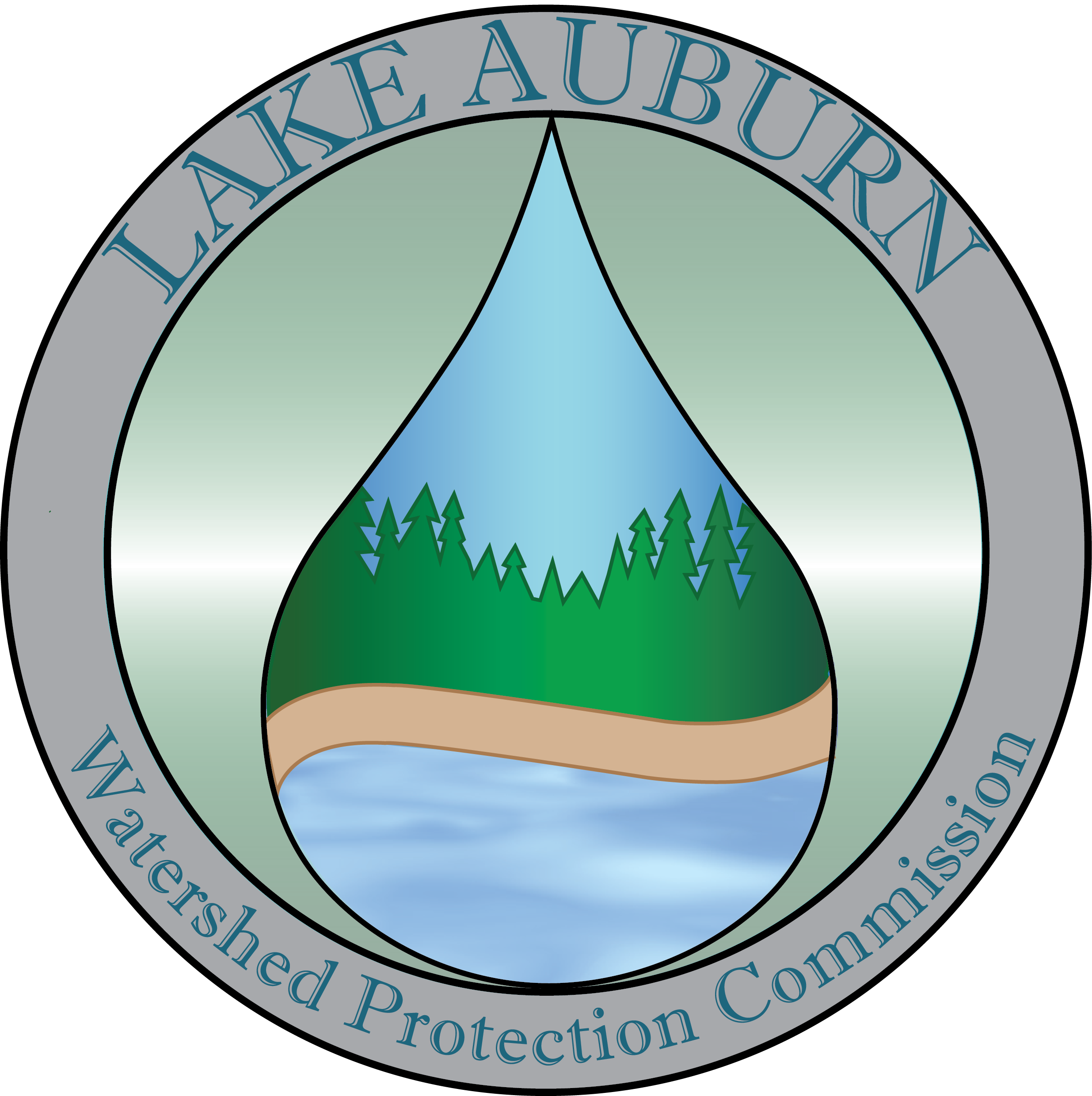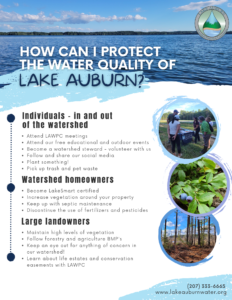Below are different ways you can help protect the water quality of Lake Auburn
Individuals – In and out of the Lake Auburn Watershed
-
- Attend LAWPC meetings – Attending watershed meetings is a great way to stay updated on policy and management in the Lake Auburn watershed. These meetings have allotted time for public comment.
Meeting dates
Meeting agendas
Meeting minutes and videos - Attend our free educational and recreational events – Our diverse events include group walks, guided nature walks, environmental workshops, art opportunities, and more. You can find our upcoming and past events on our website, newsletter, and Facebook.
- Become a watershed steward – volunteer with us! – We have opportunities for trail building, land monitoring, photography, tabling, and more.
- Follow and share our social media – Sharing our posts and information can help others learn about the Lake Auburn Watershed. Increased public knowledge of the Lake Auburn Watershed’s importance and knowledge on how to take care of it will help protect the water quality.
- Pick up any trash you see – Picking up litter, even if it is outside of watershed boundaries, keeps our community clean and helps us become better stewards.
- Plant something! – Maximizing the amount of vegetation in our community creates a healthier environment. Increased vegetation can naturally filter water, control erosion, increase wildlife, clean our air, and create stronger connections between people and their environment. Planting native plants in our yards, parks, driveways, sidewalks, streets, and front door steps is an easy way to bring more nature into our lives.
- Pick up your pet waste – Pet waste contains phosphorus, bacteria, and potentially harmful viruses that decrease water quality. Please remember your responsibility as a pet owner to pick up after your pets.
- Attend LAWPC meetings – Attending watershed meetings is a great way to stay updated on policy and management in the Lake Auburn watershed. These meetings have allotted time for public comment.
Homeowners
-
- Become LakeSmart certified – LakeSmart is an education and reward program that assists watershed homeowners to manage landscapes in ways that protect water quality. The program is free, non-regulatory and voluntary. Participating homeowners receive individualized suggestions for keeping pollutants out of stormwater and surface runoff that flows into Lake Auburn. CLICK HERE for more information on the LakeSmart program, and email our Outreach Coordinator at choutz@awsd.org if you would like to participate.
- Increase vegetation around your property – Maximizing vegetation means a healthier watershed and higher water quality! Vegetation naturally filters water, mitigates erosion, and increases wildlife. Since soils carry nutrients to nearby waterways, homeowners can help by implementing strategies on their own property to stabilize soils and allow precipitation to gently infiltrate the land. In addition, infiltration recharges groundwater used for wells, a common source of household water in the Lake Auburn watershed. The best erosion control methods simply mimic the way that nature handles the overland flow of water; slow the flow, and capture, collect, and control the speed and volume of runoff. Plant native trees, shrubs, or flowers in parts of your yard this is unused. For areas with grass, consider mowing less frequently, and keeping grass at a higher length. Vegetation including tall grass, shields the ground from the impact of rain, and decreases erosion.
- Discontinue the use of fertilizers and pesticides – While fertilizer is used to promote plant growth by adding Phosphorus into the soil, much of that fertilizer and phosphorus runs off and enters Lake Auburn, decreasing the water quality. Some alternatives to promote plant growth without adding excess phosphorus into our watershed are: using homemade compost into your garden to add nutrients, cultivating native plants, having a diverse garden to diversify soil nutrients, cover cropping and more. For more resources CLICK HERE to view our gardening page. Pesticides contain many chemicals intended to kill or harm certain parts of nature. After being applied, these chemicals can run off and enter Lake Auburn or seep into the soil, decreasing water and soil quality.
- Keep up with septic maintenance – “Septic systems can contribute pollution to Lake Auburn weather they are failing or not. Contaminants of concern include phosphorus, nitrogen, bacteria, viruses, and emerging contaminants such as pharmaceuticals and other endocrine disruptors.” (Lake Auburn Watershed Management Plan, 2010, CEI.)
- Routinely inspect your septic tank every 1-2 years
- Pump your septic tank every 3-5 years as needed
- Only flush human waste and toilet paper down the toilet
- DO NOT flush/pour down the drain the following items: bathroom wipes, feminine hygiene products, pharmaceuticals, kitchen grease, and household chemicals
For more information on septic care CLICK HERE
Large land owners
-
- Maintain high levels of vegetation – Large lots of land such as forests, wetlands, meadows, and more are where the majority of water infiltration, erosion control, and pollution abetment occur. Conserving this land, protecting the vegetation and soil, is one of the best ways to prevent and mitigate pollution.
- Follow Best Management Practices (BMP’s) for forestry and agriculture – Following these guides can help ensure a healthy watershed and healthy water quality.
Forestry BMP’s
Agriculture BMP’s - Keep an eye out for anything of concern in our watershed! – If you see erosion, invasive species, discolored water, or something out of the usual, let us know at 207-333-6665
- Consider the option of a life estate or conservation easement – Life estates or conservation easements with the Lake Auburn Watershed Protection Commission are a great way to ensure the protection of the watershed and the protection of Lake Auburn’s high water quality.
Please email Education and Outreach Coordinator, Dylan with questions dhertzberg@awsd.org

